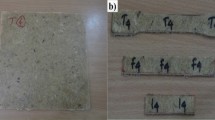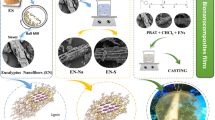Abstract
To achieve a green composite product with large range of potential applications, industries are develo** nano-sized fillers from biomass material. In the present work, the potentiality of utilizing date palm trunk fiber, as agricultural waste for the development of fire retardant nano-filler, was investigated. Two different nanofiller products (Nanofiller-55 and Nanofiller-99) were prepared from the date palm–derived microfiller through combined chemical process and high-energy ball milling. Characterization was conducted for the produced nanofiller as well as microfiller, through advanced testing analysis. From morphology examination, the nanofiller was revealed as individually dispersed nanoparticles in rectangular-like shape under transmission electron microscopy (TEM). Meanwhile, the field emission scanning electron microscopy (FESEM) presented the nanofiller particles in irregular shapes with rough surface after the breakdown of compact microfiller structure by ball milling process. The particle size analysis also proved that small nanoparticles in the mean size range of 274.5–289.7 nm were generated for both Nanofiller-55 and Nanofiller-99 samples. Furthermore, energy-dispersive X-ray (EDX) analysis presented the presence of carbon and oxygen as the major fiber elements in nanofillers, while the residual silica, sulfur, calcium, potassium elements were detected to decrease after combined treatment process. Additionally, the physico-chemical analysis revealed those nanofillers possessed great crystallinity between 58 and 67%, which could impart them as strong load-bearing agent. As for thermal analysis, both Nanofiller-55 and Nanofiller-99 samples exhibited high decomposition temperature, while showing stable degradation behavior with enhanced heat resistance. Thus, the produced nanofillers in this work can be used as fire retardant material for nanocomposites fabrication in the future.








Similar content being viewed by others
Data availability
All data used in this work, raw data available on demand.
References
Yousef S, Tatariants M, Tichonovas M, Kliucininkas L, Lukošiūtė SI, Yan L (2020) Sustainable green technology for recovery of cotton fibers and polyester from textile waste. J Clean Prod 254:120078. https://doi.org/10.1016/j.jclepro.2020.120078
Gurunathan T, Mohanty S, Nayak SK (2015) A review of the recent developments in biocomposites based on natural fibres and their application perspectives. Compos Part Appl Sci Manuf 77:1–25. https://doi.org/10.1016/j.compositesa.2015.06.007
Fonseca CS, Silva MF, Mendes RF, Hein PRG, Zangiacomo AL, Savastano JH, Tonoli GHD (2019) Jute fibers and micro/nanofibrils as reinforcement in extruded fiber-cement composites. Constr Build Mater 211:517–527. https://doi.org/10.1016/j.conbuildmat.2019.03.236
Wu J, Du X, Yin Z, Xu S, Xu S, Zhang Y (2019) Preparation and characterization of cellulose nanofibrils from coconut coir fibers and their reinforcements in biodegradable composite films. Carbohydr Polym 211:49–56
Naheed S, Tahir MP, Khalina A, Nor Azowa I (2015) Preparation and characterization of fire retardant nano-filler from oil palm empty fruit bunch fibers. BioResources 10:3
Abe K, Yano H (2010) Comparison of the characteristics of cellulose microfibril aggregates isolated from fiber and parenchyma cells of moso bamboo (Phyllostachys pubescens). Cellulose 17:271–277. https://doi.org/10.1007/s10570-009-9382-1
Liu H, Liu D, Yao F, Wu Q (2010) Fabrication and properties of transparent polymethylmethacrylate/cellulose nanocrystals composites. Bioresour Technol 101:5685–5692. https://doi.org/10.1016/j.biortech.2010.02.045
Yang HK, Lee JH, Hong WT, Jang H, Moon BK, Jeong JH, Je JY (2015) Preparation and photoluminescence properties of nano-sized SrZnO2:Sm3þ phosphor powders obtained by high-energy ball milling. Ceram Int 41:991–994. https://doi.org/10.1016/j.ceramint.2014.09.019
Abdul Khalil HPS, Fizree HM, Jawaid M, Alattas OS (2011) Preparation and characterization of nano structured materials from oil palm ash – A bioagricultural waste from oil palm mill. Bioresources 6(4):4537–4546. https://doi.org/10.15376/biores.6.4.4537-4546
Pilloni M, Nicolas J, Marsaud V, Bouchemal K, Frongia F, Scano A, Ennas G, Dubernet C (2010) PEGylation and preliminary biocompatibility evaluation of magnetite-silica nanocomposites obtained by high energy ball milling. Int J Pharm 401:103–112. https://doi.org/10.1016/j.ijpharm.2010.09.010
Nagendra PS, Prasad VVS, Ramji K (2014) Synthesis of bio-degradable banana nanofibers. Int J Innov Technol Res 2:730–734
Tammaro L, Vittoria V, Bugatti V (2014) Dispersion of modified layered double hydroxides in poly(ethylene terephthalate) by high energy ball milling for food packaging applications. Eur Polym J 52:172–180. https://doi.org/10.1016/j.eurpolymj.2014.01.001
Lee CH, Sapuan MS, Hassan MR (2014) A review of the flammability factors of kenaf and allied fibre reinforced polymer composites. Adv Mater Sci Eng 514036:1–8. https://doi.org/10.1155/2014/514036
Padal KTB, Ramji K, Prasad VVS (2014) Isolation and characterization of jute nano fibres. Int J Mech Eng 3:422–428. https://doi.org/10.18178/ijmerr
Yu Y, Zhang Y, ** L, Zhao Z, Huo S, Huang G, Fang Z, Song P (2022) Interface nanoengineering of a core-shell structured biobased fire retardant for fire-retarding polylactide with enhanced toughness and UV protection. J Clean Prod 336:130372. https://doi.org/10.1016/j.jclepro.2022.130372
Zhang Y, **g J, Liu T, ** L, Sai T, Ran S, Fang Z, Huo S, Song P (2021) A molecularly engineered bioderived polyphosphate for enhanced flame retardant, UV-blocking and mechanical properties of poly(lactic acid). Chem Eng J 411:128493. https://doi.org/10.1016/j.cej.2021.128493
Zhang Y, **ong Z, Ge H, Ni L, Zhang T, Huo S, Song P, Fang Z (2020) Core–shell bioderived flame retardants based on chitosan/alginate coated ammonia polyphosphate for enhancing flame retardancy of polylactic acid. ACS Sustainable Chem Eng 8(16):6402–6412. https://doi.org/10.1021/acssuschemeng.0c00634
**ong Z, Zhang Y, Du X, Song P, Fang Z (2019) Green and scalable fabrication of core–shell biobased flame retardants for reducing flammability of polylactic acid. ACS Sustainable Chem Eng 7(9):8954–8963. https://doi.org/10.1021/acssuschemeng.9b01016
Yang H, Yu B, Xu X, Bourbigot S, Wang H, Song P (2020) Lignin-derived bio-based flame retardants toward high-performance sustainable polymeric materials. Green Chem 22:2129–2161. https://doi.org/10.1039/D0GC00449A
Lou G, Ma Z, Dai J, Bai Z, Fu S, Huo S, Qian L, Song P (2021) Fully biobased surface-functionalized microcrystalline cellulose via green self-assembly toward fire-retardant, strong, and tough epoxy biocomposites. ACS Sustainable Chem Eng 9(40):13595–13605. https://doi.org/10.1021/acssuschemeng.1c04718
Yang H, Shi B, Xue Y, Ma Z, Liu L, Liu L, Yu Y, Zhang Z, Annamalai PK, Song P (2021) Molecularly engineered lignin-derived additives enable fire-retardant, uv-shielding, and mechanically strong polylactide biocomposites. Biomacromol 22(4):1432–1444. https://doi.org/10.1021/acs.biomac.0c01656
Yin W, Chen L, Lu F, Song P, Dai J, Meng L (2018) Mechanically robust, flame-retardant poly(lactic acid) biocomposites via combining cellulose nanofibers and ammonium polyphosphate. ACS Omega 3(5):5615–5626. https://doi.org/10.1021/acsomega.8b00540
Feng J, Sun Y, Song P, Lei W, Wu Q, Liu L, Yu Y, Wang H (2017) Fire-resistant, strong, and green polymer nanocomposites based on poly(lactic acid) and core–shell nanofibrous flame retardants. ACS Sustainable Chem Eng 5(9):7894–7904. https://doi.org/10.1021/acssuschemeng.7b01430
Liu L, Huang G, Song P, Yu Y, Fu S (2016) Converting industrial alkali lignin to biobased functional additives for improving fire behavior and smoke suppression of polybutylene succinate. ACS Sustainable Chem Eng 4(9):4732–4742. https://doi.org/10.1021/acssuschemeng.6b00955
Alotaibi MD, Alshammari BA, Saba N, Alothman OY, Sanjay MR, Almutairi Z, Jawaid M (2019) Characterization of natural fiber obtained from different parts of date palm tree (Phoenix dactylifera L.). Int J Biol Macromol 135:69–76. https://doi.org/10.1016/j.ijbiomac.2019.05.102
Bazrafshan O, Zamani H, Ramezanietedli H, Moshizi ZG, Shamili M, Ismaelpour Y, Gholami H (2020) Improving water management in date palms using economic value of water footprint and virtual water trade concepts in Iran. Agric Water Manage 229:105941. https://doi.org/10.1016/j.agwat.2019.105941
Amor ZH, Acharjee TK, Dhaouadi L, Bouri S (2020) Impacts of climate change on irrigation water requirement of date palms under future salinity trend in coastal aquifer of Tunisian oasis. Agric Water Manage 228:105843. https://doi.org/10.1016/j.agwat.2019.105843
Majed DA, Basheer AA, Saba N, Alothman OY, Kian LK, Khan A, Jawaid M (2020) Microcrystalline cellulose from fruit bunch stalk of date palm: isolation and characterization. J Polym Environ 28:1766–1775. https://doi.org/10.1007/s10924-020-01725-8
Amina H, Benalia K, Kian LK, Asim M, Jawaid M (2019) Extraction and characterization of microcrystalline cellulose from date palm fibers using successive chemical treatments. J Polym Environ 29:1–10. https://doi.org/10.1007/s10924-020-02012-2
Alothman OY, Kian LK, Naheed S, Jawaid M, Ramzi K (2021) Cellulose nanocrystal extracted from date palm fibre: morphological, structural and thermal properties. Ind Crops Prod 159:113075. https://doi.org/10.1016/j.indcrop.2020.113075
Haafiz MKM, Eichhorn SJ, Hassan A, Jawaid M (2013) Isolation and characterization of microcrystalline cellulose from oil palm biomass residue. Carbohydr Polym 93:628–634. https://doi.org/10.1016/j.carbpol.2013.01.035
Rosa SML, Rehman N, De Miranda MIG, Nachtigall SMB, Bica CID (2012) Chlorine-free extraction of cellulose from rice husk and whisker isolation. Carbohydr Polym 87:1131–1138
Acknowledgements
The authors would like to extend their gratitude to King Saud University (Riyadh, Saudi Arabia) for funding this research through Researchers Supporting Project number (RSP-2021/241).
Funding
The authors would like to extend their gratitude to King Saud University (Riyadh, Saudi Arabia) for funding this research through Researchers Supporting Project number (RSP-2021/241).
Author information
Authors and Affiliations
Contributions
M.Jawaid: Investigation, methodology, writing (review and editing), formal analysis. Lau Kia Kian: Conceptualization, investigation, methodology, supervision, writing—review and editing. Salman Almery: Conceptualization, writing (review and editing), and funding. Naheed Saba: Investigation, writing—review and editing. Hassan Fouad: Investigation, writing—review and editing. Othman Y Alothman: Investigation, writing—review and editing. M. Sain: Investigation, writing—review and editing.
Corresponding author
Ethics declarations
Ethical approval
No ethical clearance is required.
Conflict of interest
The authors declare no competing interests.
Human and animal rights
We declare that there are no animal studies or human participant involvement in the study.
Additional information
Publisher's note
Springer Nature remains neutral with regard to jurisdictional claims in published maps and institutional affiliations.
Rights and permissions
Springer Nature or its licensor holds exclusive rights to this article under a publishing agreement with the author(s) or other rightsholder(s); author self-archiving of the accepted manuscript version of this article is solely governed by the terms of such publishing agreement and applicable law.
About this article
Cite this article
Jawaid, M., Kian, L.K., Alamery, S. et al. Development and characterization of fire retardant nanofiller from date palm biomass. Biomass Conv. Bioref. 14, 9109–9119 (2024). https://doi.org/10.1007/s13399-022-03226-1
Received:
Revised:
Accepted:
Published:
Issue Date:
DOI: https://doi.org/10.1007/s13399-022-03226-1




